
Majlis is an Arabic term meaning "sitting room", used to describe various types of special gatherings among common interest groups of administrative, social or religious nature in countries with linguistic or cultural connections to Islamic countries. The Majlis can refer to a legislature as well and is used in the name of legislative councils or assemblies in some of the states where Islamic culture dominates.
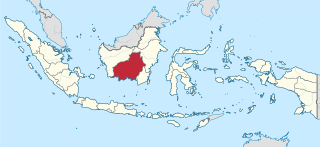
Central Kalimantan is a province of Indonesia. It is one of five provinces in Kalimantan, the Indonesian part of Borneo. It is bordered by West Kalimantan to the west, South Kalimantan and East Kalimantan to the east, Java Sea to the south and is separated narrowly from North Kalimantan and Malaysia by East Kalimantan's Mahakam Ulu Regency. Its provincial capital is Palangka Raya and in 2010 its population was over 2.2 million, while the 2020 Census showed a total of almost 2.67 million; the official estimate as at mid 2022 was 2,741,075.

Topeng is a dramatic form of Indonesian dance in which one or more mask-wearing, ornately costumed performers interpret traditional narratives concerning fabled kings, heroes and myths, accompanied by gamelan or other traditional music instruments. Topeng dance is a typical Indonesian dance that can be found in various regions in Indonesia. Topeng dance has the main characteristic that the dancers use masks to cover their faces. The dance will usually be performed by one dancer or a group of dancers.

The national emblem of Indonesia is called Garuda Pancasila. The main part is the Garuda with a heraldic shield on its chest and a scroll gripped by its legs. The shield's five emblems represent Pancasila, the five principles of Indonesia's national ideology. The Garuda claws gripping a white ribbon scroll inscribed with the national motto Bhinneka Tunggal Ika written in black text, which can be loosely translated as "Unity in Diversity". Garuda Pancasila was designed by Sultan Hamid II from Pontianak, supervised by Sukarno, and was adopted as the national emblem on 11 February 1950.

The Murut are an indigenous ethnic group, comprising 29 sub-ethnic groups inhabiting the northern inland regions of Borneo. The Murutic languages are a family of half a dozen closely related Austronesian languages. The Murut can be found mainly in Sabah, but also in Sarawak, Brunei, and Kalimantan, Indonesia.

Mandau is the traditional weapon of the Dayak people of Borneo. It is also known as Parang Ilang among the Bidayuh, Iban and Penan people, Malat by the Kayan people or Baieng by the Kenyah people or Bandau by Lun Bawang or Pelepet/Felepet by Lundayeh. Mandau is mostly ceremonial. However, a less elaborate version called Ambang is used as an everyday practical tool.
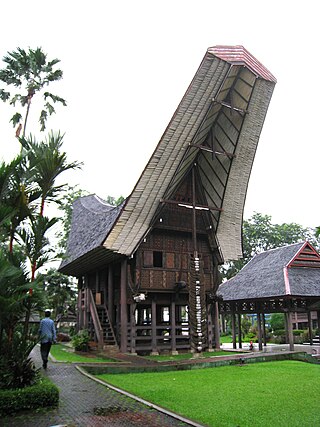
Tongkonan is the traditional ancestral house, or rumah adat of the Torajan people, in South Sulawesi, Indonesia. Tongkonan have a distinguishing boat-shaped and oversized saddleback roof. Like most of Indonesia's Austronesian-based traditional architecture, tongkonan are built on piles. The construction of tongkonan is laborious work and it is usually built with the help of all family members or friends. In the original Toraja society, only nobles had the right to build tongkonan. Commoners live in smaller and less decorated homes called banua.

The art of the Upper Paleolithic represents the oldest form of prehistoric art. Figurative art is present in Europe and Southeast Asia, beginning between about 40,000 to 35,000 years ago. Non-figurative cave paintings, consisting of hand stencils and simple geometric shapes, are somewhat older, at least 40,000 years old, and possibly as old as 64,000 years. This latter estimate is due to a controversial 2018 study based on uranium-thorium dating, which would imply Neanderthal authorship and qualify as art of the Middle Paleolithic.

The national costume of Indonesia is the national attire that represents the Republic of Indonesia. It is derived from Indonesian culture and Indonesian traditional textile traditions. Today the most widely recognized Indonesian national attires include batik and kebaya, although originally those attires mainly belong within the island of Java and Bali, most prominently within Javanese, Sundanese and Balinese culture. Since Java has been the political and population center of Indonesia, folk attire from the island has become elevated into national status.
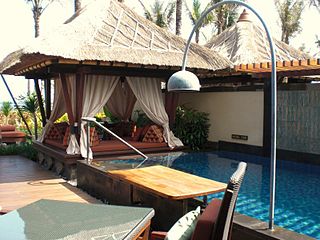
Balinese architecture is a vernacular architecture tradition of Balinese people that inhabits volcanic island of Bali, Indonesia. The Balinese architecture is a centuries-old architectural tradition influenced by Balinese culture developed from Hindu influences through ancient Javanese intermediary, as well as pre-Hindu elements of native Balinese architecture.
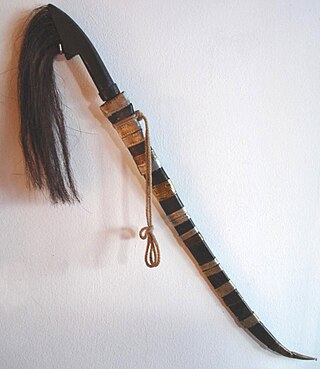
The surik is a traditional sword native to the island of Timor or Nusa Tenggara in wider extent, as well as Sumatra. The first coat of arms of East Timor depicted crossed suriks.

Niabor is a curved sword from Borneo, a characteristic weapon of the Sea-Dayaks.

Langgai Tinggang is a traditional sword of the Sea Dayak people, originating from Borneo. The name Langgai Tinggang means "the longest tail-feather of a hornbill".

The Pandat is the war sword of the Dayak people of northwest Borneo and is never used as a tool. On October 18, 2016, this weapon was featured in season 3 episode 9 of the American bladesmithing competition series Forged in Fire.

Kurabit is a traditional shield originating from the Mentawai Islands off the coast of West Sumatra, Indonesia.

A Salawaku, is a traditional shield originating from the Maluku Islands, Indonesia. It is also known as Ma Dadatoko, Salwake, Saluwaku or Salawako in Galela, Salawakunu in Loloda, Hawau-mu in Madole, Emuli in Buru or O Dadatoko in Tobelo.

Baluse or Baloese is a traditional shield of the Nias people originating from Nias, an island off the west coast of North Sumatra, Indonesia. Baluse in the Northern Nias is somewhat smaller than those of the rest of the island.

The Kanta is a traditional shield of the Toraja and Pamona people of Tana Toraja Regency, South Sulawesi and Poso Regency, Central Sulawesi, Indonesia respectively.

Katapu or Kalapu is a traditional war cap or helmet used by the Dayaks of Borneo. The katapu is only worn during war.
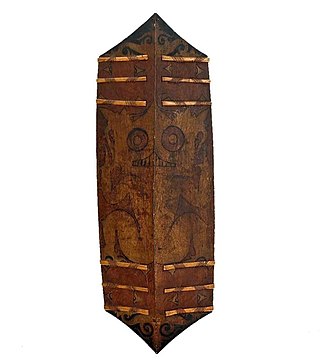
The Kliau, Keliau or Klau is a traditional shield of the Dayak people of Borneo. It is similar to the shields used by other Dayak people such as the Klebit Bok of the Kenyah. Other names for this shield include: klawang or kelawang and trabai or terabai.























